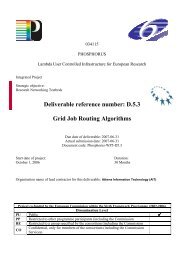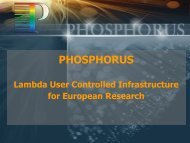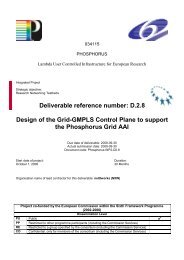D5.9: Extended Simulation Environment - Phosphorus
D5.9: Extended Simulation Environment - Phosphorus
D5.9: Extended Simulation Environment - Phosphorus
Create successful ePaper yourself
Turn your PDF publications into a flip-book with our unique Google optimized e-Paper software.
D5.6 - <strong>Extended</strong> <strong>Simulation</strong> <strong>Environment</strong><br />
Receive Data<br />
Send using<br />
OCSSender as<br />
part of a previous<br />
circuit<br />
Yes<br />
Sending Ok<br />
No<br />
Check if this node<br />
is beginning of a<br />
circuit to the data‟s<br />
destination<br />
Yes<br />
Is Beginning <br />
No<br />
Sending finished<br />
Send using<br />
OBSSender<br />
Send using<br />
OCSSender<br />
Figure 4 Execution flow of a HybridSender.<br />
4.4 Running a simulation<br />
Defining a simulation scenario and running it, it is done by writing a Java program, using the classes and<br />
interfaces implemented by our framework.<br />
First the Simulator and SimulatorInstance objects should be created. The SimulatorInstance receives<br />
as input parameter the location of the configuration file which contains the standard parameters for the<br />
simulation, such as the number of wavelengths per link, the processing power of a resource core, etc.<br />
Individual parameters can be altered by invoking the corresponding setter method on that entity for that<br />
parameter.<br />
simInstance = new Grid<strong>Simulation</strong>("configFiles\\loadCircuits.cfg");<br />
simulator = new GridSimulator();<br />
Project:<br />
<strong>Phosphorus</strong><br />
Deliverable Number: <br />
Date of Issue: 2009-03-31<br />
EC Contract No.: 034115<br />
Document Code: <br />
22






